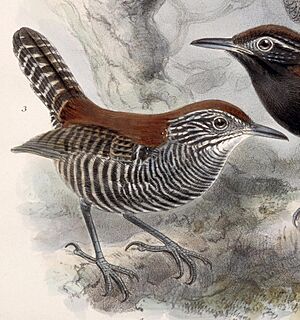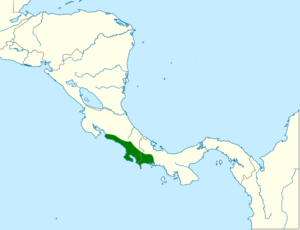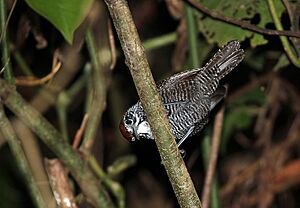Riverside wren facts for kids
Quick facts for kids Riverside wren |
|
|---|---|
 |
|
| Conservation status | |
| Scientific classification | |
| Genus: |
Cantorchilus
|
| Species: |
semibadius
|
 |
|
| Synonyms | |
|
Thryothorus semibadius |
|
The riverside wren (scientific name: Cantorchilus semibadius) is a small, lively bird. It belongs to the wren family, called Troglodytidae. You can find this bird living in the countries of Costa Rica and Panama.
Contents
About the Riverside Wren's Family Tree
Scientists study how different animals are related. This is called taxonomy. Some people used to think the riverside wren was the same species as the bay wren. But these two birds look very different. Also, their DNA is not the same. This means they are separate species. The riverside wren is a monotypic species. This means it does not have any different subspecies.
What Does the Riverside Wren Look Like?
The riverside wren is a small bird. It is about 13 to 14 centimeters (5 to 5.5 inches) long. It weighs around 17 grams (0.6 ounces). Adult riverside wrens have a bright orange-brown color on their head. Their neck, back, and rump are a chestnut brown. Their tail is dark, almost black, with light, buff-white stripes.
They have a black stripe above their eye, with a white stripe right below it. The rest of their face has black and white streaks and spots. From their throat down to their belly, their feathers are light gray. These gray feathers have thin black stripes. The gray color becomes a bit more buff-colored towards their tail. Young wrens are not as brightly colored. They have fine black marks on their head. The black stripes on their belly are also not as clear.
Where Does the Riverside Wren Live?
The riverside wren lives along the Pacific coast. You can find it from the Gulf of Nicoya in Costa Rica. Its home stretches into the western part of Panama. This bird likes to live in thick plants. It especially likes areas near rivers or streams. It also lives in swampy parts of forests. Sometimes, it can be found on steep cliffs. It lives from sea level up to about 1,200 meters (3,900 feet) high.
How Does the Riverside Wren Behave?
What Does the Riverside Wren Eat?
The riverside wren usually looks for food near the ground. It often hunts in pairs or with its family. Sometimes, it will join other bird species. They all look for food together when army ants are swarming. The wren's diet includes insects and other small creatures without backbones. These are called invertebrates.
Reproduction and Nests
Riverside wrens seem to build nests and lay eggs almost all year round. Their nest is shaped like a ball. It is made from thin plant fibers. The nest hangs over a branch. It has two rooms inside. The entrance hole is in the outer room. These nests are often built over flowing water. They are usually 1.5 to 2.2 meters (5 to 7 feet) above the water or the ground. These wrens also build special "dormitory" nests. These are just for sleeping in. A female wren usually lays two eggs at a time.
What Sounds Does the Riverside Wren Make?
Both male and female riverside wrens sing. Their songs are "loud, ringing phrases" that are repeated. They then sing different phrases, which are also repeated. Their calls include a "harsh churr" sound. They also make various clear, tinkling notes.
Is the Riverside Wren in Danger?
The IUCN (International Union for Conservation of Nature) checks on animals. They have said the riverside wren is of "Least Concern." This means it is not currently in danger of disappearing. However, it is hard to know if their numbers are changing. This is because we are not sure how changes to their home affect how many wrens there are.



